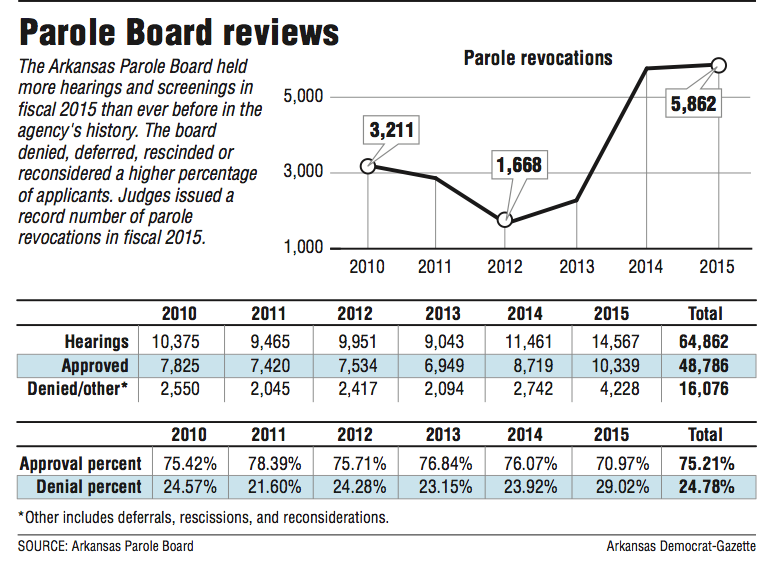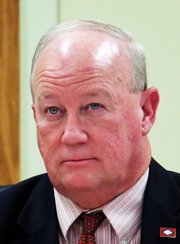The number of state parole cases increased by nearly 41 percent over the past five years, going from 10,375 cases in 2010 to 14,567 in 2015.
The Arkansas Parole Board ended the fiscal year with the highest number of parole application reviews in the agency's history, according to an annual report.
The increase shown in the report illustrates a problem facing policymakers: how to handle the workload on the state's penal system, including parole supervising agencies.
"It makes us re-examine everything we're doing," said Dina Tyler, a deputy director for Arkansas Community Correction, the state agency that supervises those offenders who are on parole or probation. "Our goal is for offenders to successfully return to the community. That means they stay on parole, do what they're required to do and they don't commit additional crimes. So when the number of returns has a dramatic increase, we need to make adjustments."
Solomon Graves, the top administrator for the Parole Board, said that at the same time his agency is working with an increasing number of parolees, the Arkansas Department of Correction is seeing an increase in inmates.
"This isn't just a one-trick pony that is driving these increases," Graves said.
The increase in the prison and parole populations are largely because of stricter parole policies enacted in 2013 after a series of Arkansas Democrat-Gazette articles shed light on the state's parole system through the case of an eight-time parole absconder, Darrell Dennis, who was convicted in May of kidnapping and killing a teenager in Little Rock.
The number of Arkansans on parole increased to 24,523 in 2013, thousands more than the 14,770 on parole in 2004, according to statistics from the Council of State Governments Justice Center.
There are currently 17,707 people in Arkansas prisons. Another 53,000 under parole or probation supervision, which includes about 1,700 residing at Arkansas Community Correction facilities. There also are about 1,100 in county jails waiting for beds to open up in prison facilities, according to latest population reports.
"You know what the backup does, it creates issues with sheriffs around the state and you feel for them," said John Felts, Parole Board chairman and Board of Corrections member. "You try to do those things that will be helpful to them and at the same time maintain safety in the streets. Sometimes it's a chess game. It really is."
The report also showed that the Parole Board denied parole for a higher number and percentage of inmates in 2015 than in any of the previous five years. Of the 14,567 hearings or screenings held in 2015, more than 29 percent, or 4,228, were denied while 71 percent -- or 10,339 -- were approved for release.
None of the denial percentages from 2010 through 2014 were over 25 percent, with the highest being in 2010 when nearly 25 percent, or 2,550 of the 10,375 applications reviewed, were denied, deferred, rescinded or reconsidered.
Since 2010, the Parole Board has denied about 25 percent of the 64,862 applications it reviewed. That means 16,076 inmates remained behind bars while 48,786 -- or more than 75 percent -- were approved for release, according to the report.
"It's not really a pretty picture there," Felts said. "When your numbers go up and you're doing 1,500 a month with all the different type hearings we do, it's just unbelievable the amount of time that goes into it."
The parole system is different for each state in the nation, making a comparison with Arkansas difficult. Each state's board makeup and reporting procedures are different.
But some states are releasing fewer parolees. In Texas, for example, of the 77,300 parole considerations, only about 36 percent -- or 27,500 -- were approved for release. In Iowa, about 32 percent, or 3,606 of the 11,371 inmates who requested parole, were approved.
"I just ended my 18th year of working with parole and there has been continuous growth," Felts said. "Unfortunately, with the business we're in, it's going to grow until some of the things such as re-entry [programs] and so forth begin to work and we have an effect on recidivism."
Parole revocations -- those who were released but violate the terms of their parole -- also reached record highs in 2015, increasing by nearly 83 percent in the past five years. In 2010, there were 3,211 revocations made by judges or by inmates who waived a hearing and opted to voluntarily return to prison for violating conditions of their parole.
In 2015, that number rose to 5,862 revocations -- a slight increase over the 5,761 revocations in 2014.
Of the 5,862 parole revocations last year, about 55 percent were sent back to prison because of a combination of a technical parole violation and committing a new crime, while about 15 percent were revoked solely based on new charges.
Nearly 31 percent, or 1,781, were sent back to prison solely for a technical violation -- such as skipping a meeting with a parole officer, failing a drug test, or associating with people the offender was ordered to avoid -- without committing a new crime.
About 60 percent of the inmates whose parole was revoked are sitting in prison without having their crime fully adjudicated in the court system, according to data from JFA Associates, a Colorado organization that collects and analyzes data for the state.
"That means that somewhere along the way through a nolle prose, or a dropped case, or in some instances, cases that were never filed even, that person has been incarcerated for seven to eight months without having a criminal conviction," Felts said.
The numbers in the Parole Board's annual report for 2015, while troubling, do not reflect changes the Parole Board and Board of Corrections have made in the past several months, Felts said.
"I think that with our next annual report, it's going to show some of the policies and procedures that we've enacted since then," Felts said.
Those initiatives include the overhaul of the "Offender Violation Guide" in August by the Parole Board and the Board of Corrections.
The changes established a sanction guide that assigns a certain number of points based on the severity of a new offense by a parole violator.
Previously, all technical violations were weighted the same regardless of the severity, and the offender was re-incarcerated. Violators also were referred to the Parole Board for possible revocation after three violations, regardless of how minor the offenses.
Under the new system, parole officers will submit a violation report to the Parole Board only after an offender's combined violations reach 40 points using the new weighted guidelines.
Violations older than a year drop from the accumulated points.
Those offenders charged with a felony, a violent or sex-related misdemeanor, or those who used a weapon during the commission of a crime will be immediately jailed and held for a revocation hearing.
"The worse the violation, the heavier the weight. Through supervision and other sanctions, we can keep a parolee in the community safely for lighter violations," Tyler said. "For instance, someone who tests positive for marijuana doesn't necessarily need to go back to ADC. But they do need treatment. We had one offender who got charged for taking his girlfriend's cellphone during an argument.
"He was locked up for it, even though the charges were dropped. We're trying to be smarter about what we do and who we request a parole revocation on. Public safety is our top priority, but we also have to consider the finite amount of prison beds. If we can manage someone adequately in the community, let's not send them back just for sneezing backward."
The Parole Board also has created a system in which inmates can reduce their usual six-month jail time for parole violations to 90 days by signing a waiver and meeting standards of conduct during the three months.
"I don't want to try to pass off to anybody whose fault that may be, but if you've got a hundred people that you say have committed even a low-level crime and we're bringing those people back, are we doing the right thing for the whole system?" Felts said. "Yeah, we're taking them off the street, true enough, but again, was it worth filling up a bed in the penitentiary for those charges that for some may never come to fruition?"
Felts said Gov. Asa Hutchinson's prison plan, unveiled in early 2015, also will have an effect. Part of that plan calls for 500 beds for soon-to-be parolees at regional "re-entry centers" where inmates would undergo training and treatment.
"With some of the low-level felonies, unfortunately a lot of those are drug-addicted people," Felts said. "They get caught in possession of drugs. Again, do they need to be fixed? Yes. But is prison going to be that fix? For a lot of them, it's not -- unless we address that need while they're incarcerated."
Although it's a lower priority because of resources, Felts said, it would be ideal if the life-skills courses offered to inmates who are within a certain number of months of parole, also be made available to those inmates with longer sentences, right from the beginning.
The average time on the waiting list for classes such as Thinking Errors, substance-abuse education, anger management, and others is three to six months just for those inmates who are stipulated by the Parole Board to attend.
"Too often, again, a parolee will leave out of the Department of Correction with a $100 card, a bus ticket and an 'I hope everything works out for you,'" Felts said. "We certainly have more needs than seats available in the classrooms to address certain needs."
J.R. Davis, spokesman for Hutchinson, said the first goal of the re-entry centers is to help decrease the prison population.
"Most critically, the governor's desire is to change behavior," Davis said. "This concept had never been tried before in Arkansas. It is great to find out if this can work and if we can make a substantive impact on individuals looking to get a second chance."
The numbers are already improving. The state inmates in county jails awaiting an open prison bed has declined from more than 2,900 last spring to 1,142.
"The numbers continue to drop," Davis said. "We were pushing 3,000 in the backup and the numbers we see now reflect a real substantive policy change. We feel really good about it."
Felts said he is looking forward to the Parole Board's report for 2016.
"We already know that the picture is going to be much more favorable. It's going to show that we've made some changes in some areas and it's going to be be reflective of success in those," he said. "There's just a lot of good things that can come from that. But most of all, we are hoping that people's lives will be affected in such a way that they understand that life is precious. Parole is not a right; it's a privilege, and we hope they will treat it like that and be successful citizens."
A Section on 02/04/2016


